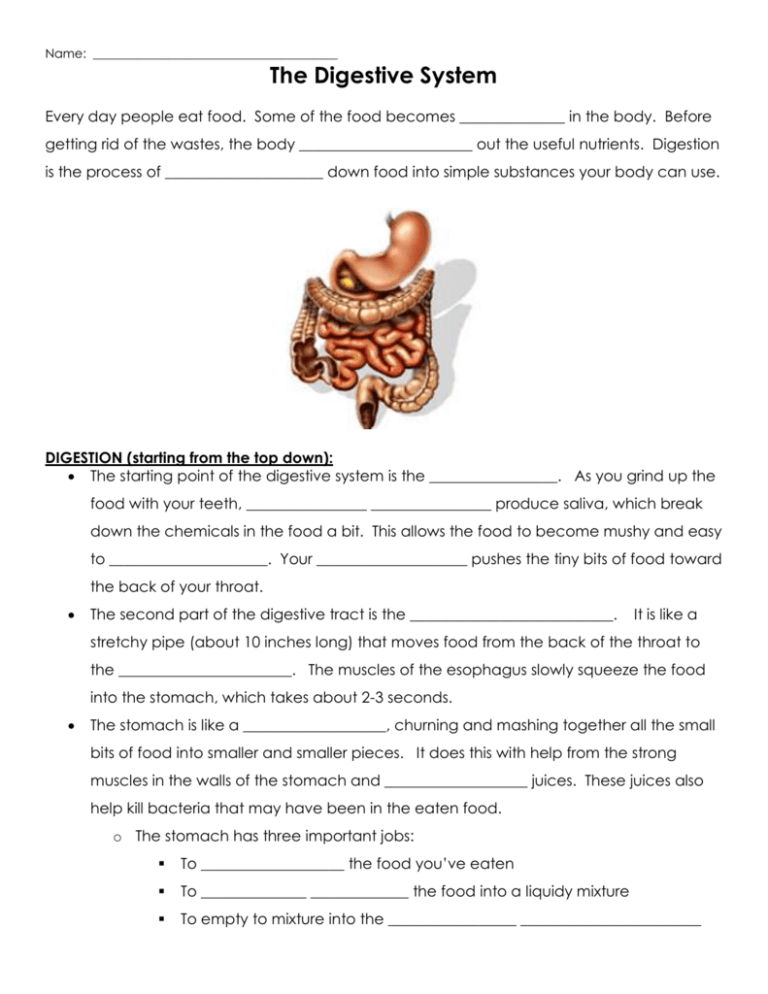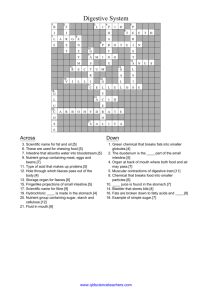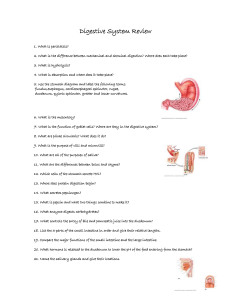digestive system class notes
advertisement

Name: _______________________________________ The Digestive System Every day people eat food. Some of the food becomes ______________ in the body. Before getting rid of the wastes, the body _______________________ out the useful nutrients. Digestion is the process of _____________________ down food into simple substances your body can use. DIGESTION (starting from the top down): The starting point of the digestive system is the _________________. As you grind up the food with your teeth, ________________ ________________ produce saliva, which break down the chemicals in the food a bit. This allows the food to become mushy and easy to _____________________. Your ____________________ pushes the tiny bits of food toward the back of your throat. The second part of the digestive tract is the ___________________________. It is like a stretchy pipe (about 10 inches long) that moves food from the back of the throat to the _______________________. The muscles of the esophagus slowly squeeze the food into the stomach, which takes about 2-3 seconds. The stomach is like a ___________________, churning and mashing together all the small bits of food into smaller and smaller pieces. It does this with help from the strong muscles in the walls of the stomach and ___________________ juices. These juices also help kill bacteria that may have been in the eaten food. o The stomach has three important jobs: To ___________________ the food you’ve eaten To ______________ _____________ the food into a liquidy mixture To empty to mixture into the _________________ ________________________ The small intestine is a long tube about ______ feet long packed beneath the stomach. It breaks down the food mixture even more so your body can absorb all the vitamins, minerals, proteins, carbohydrates, and fats. Food can stay in the small intestine for 4 to 5 hours while it digests. This is possible with help from the _________________________, ___________________, and ________________________________, which all send digestive juices to different parts of the small intestines. o The pancreas makes most of the juices that help the body digest _________ and ______________________. o Gastric juices from the liver are called ______________, which helps to absorb fats into the bloodstream. The liver also filters out harmful wastes turning them into more bile. It also helps figure out how many nutrients will go to the rest of the body, and how many will stay behind in storage. o The gallbladder serves as a ___________________________ for bile, storing it until the body needs it. Once food leaves the small intestine, it enters the ________________ __________________. It is a tube about 5 feet long. It has a larger diameter than the small intestine. Remaining water and nutrients are removed, and the left over waste- parts of the food that your body can’t use- are moved to the _____________________, which is the last part of the digestive tract. The solid waste stays here until it is pushed through the _______________.











